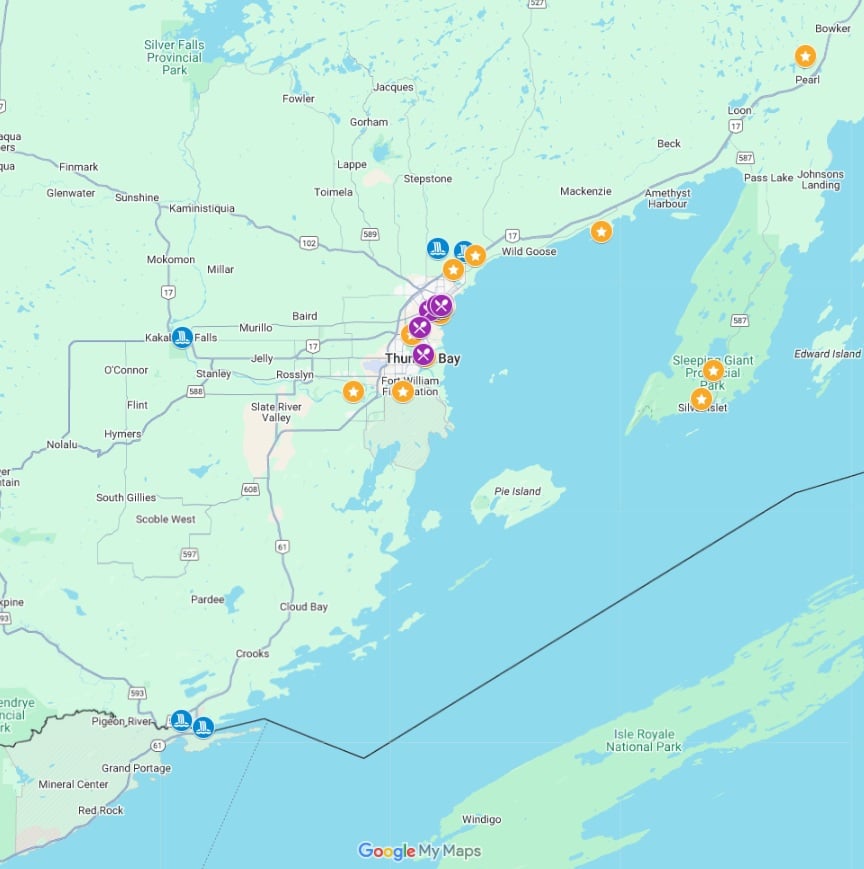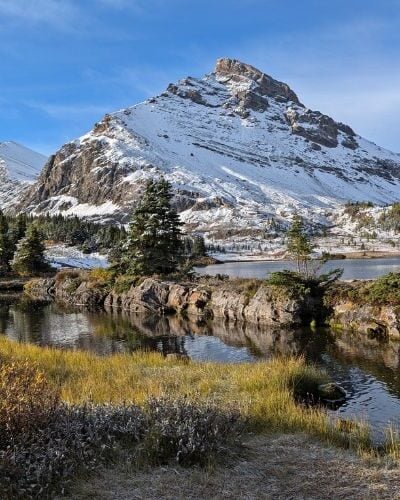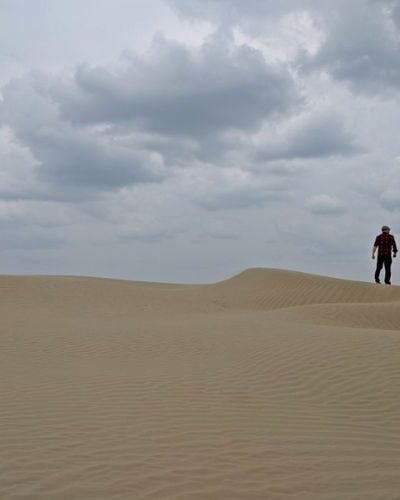If you love the outdoors, Thunder Bay deserves a spot on your Canadian bucket list. This Northwestern Ontario city blends industrial grit with beautiful natural surroundings. With Lake Superior and the Canadian Shield as a backdrop, Thunder Bay is an outdoor adventure playground.
And better still, there’s something for everyone, from accessible, close-to-town waterfalls and viewpoints to challenging hiking trails and remote, off-the-grid canoe tripping adventures.
We had passed through Thunder Bay a few times on our drives across the country. A dedicated trip, however, revealed how much we had missed. For example, the city is a hotspot for waterfalls and rock climbing.
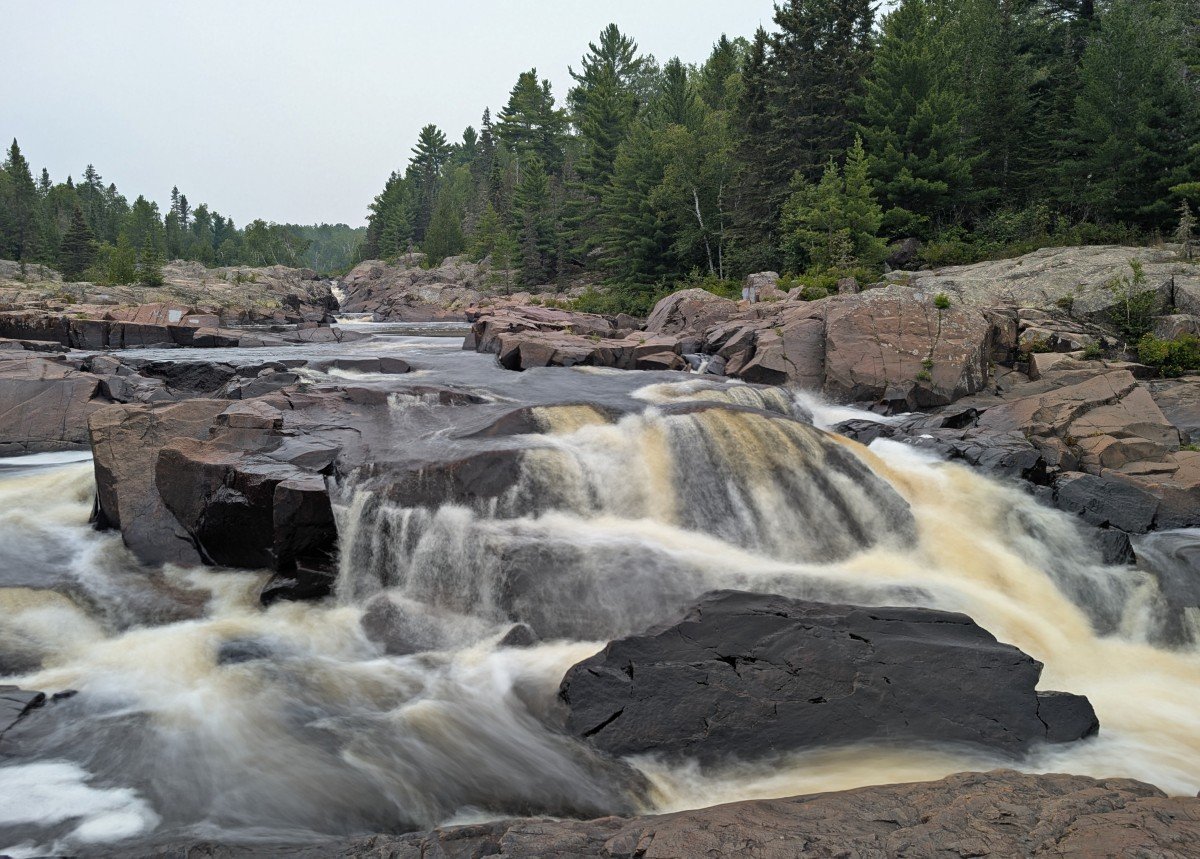
As canoe paddlers, we were familiar with Thunder Bay as a gateway to the famous Quetico Provincial Park. But we’d never heard of a larger, more remote paddling destination to the north called Wabakimi Provincial Park.
In short, there’s so much more to Thunder Bay than we initially realised. Beyond the outdoor adventure opportunities, there is an excellent food scene, thriving arts community and choice of historic attractions, all coming together to make the city a well-rounded travel destination.
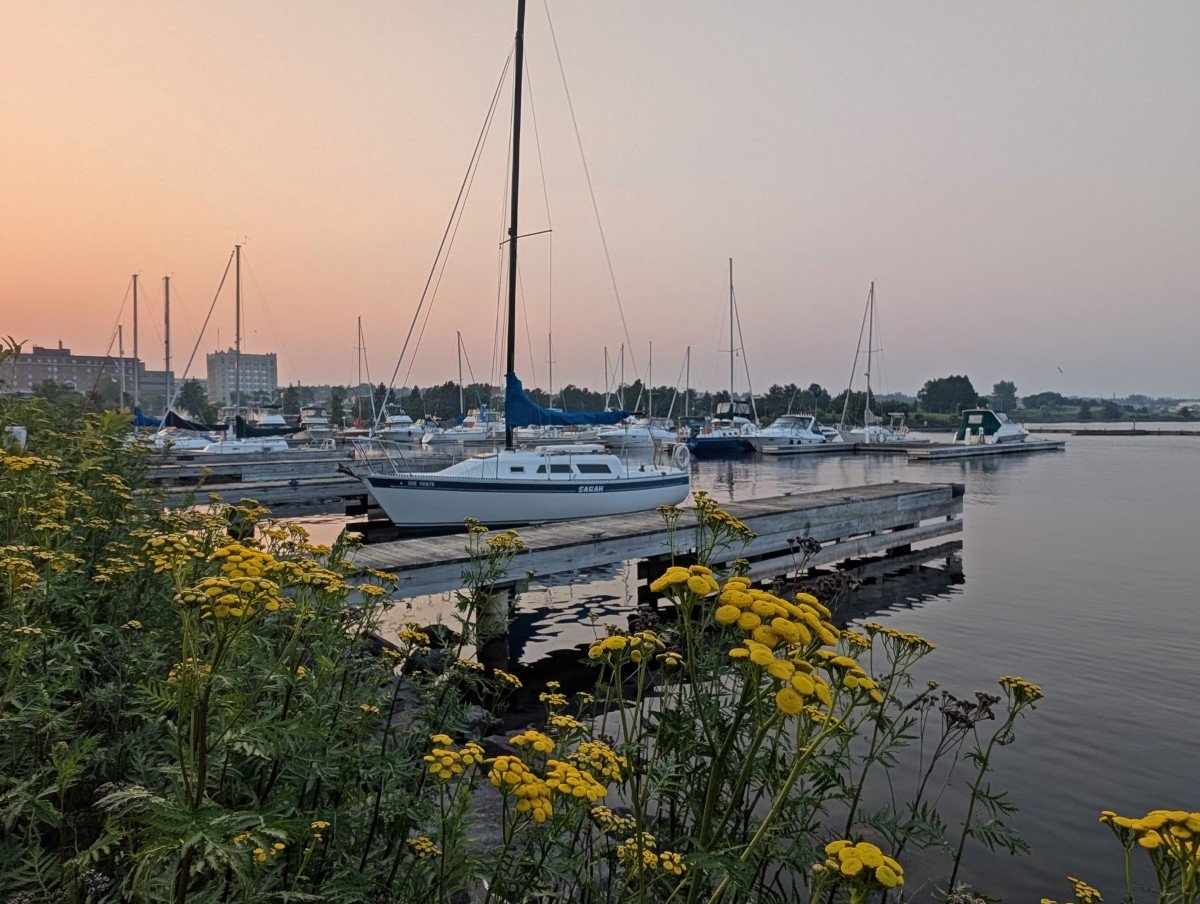
In this post, I’m going to share all of our favourite tried and tested outdoor experiences in Thunder Bay, along with our favourite places for a post-hike beer and meal. I’ll also highlight places to stay and other activities to enjoy in and around the city.
We visited Thunder Bay in July/August 2025 partnership with Tourism Thunder Bay.
This post includes some affiliate links. If you make a purchase via these links, we may receive a small percentage of the sale.
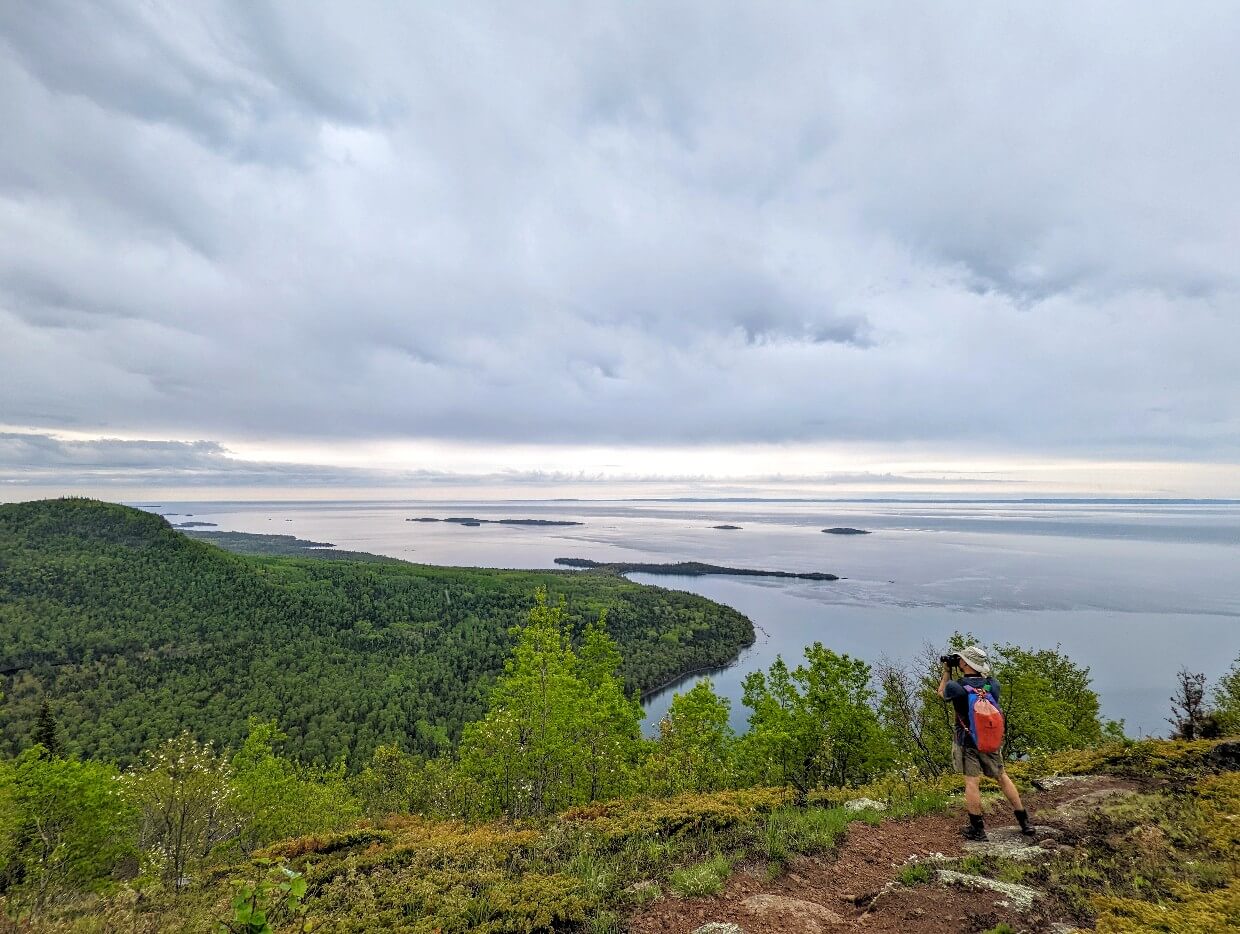
The city of Thunder Bay, Ontario
Thunder Bay sits on the traditional lands of the Anishnabek, including the Ojibwe of Fort William First Nation, who have lived here for thousands of years. Europeans learned the area was called Animikie (“Thunder”), later marked on French maps as Baie du Tonnerre (Thunder Bay).
In 1803, the North West Company built their inland headquarters on the Kaministiquia River and named it Fort William. For a time, it was the centre of Canada’s fur trading economy. After merging with the Hudson’s Bay Company and with mining on the rise, operations moved downstream.
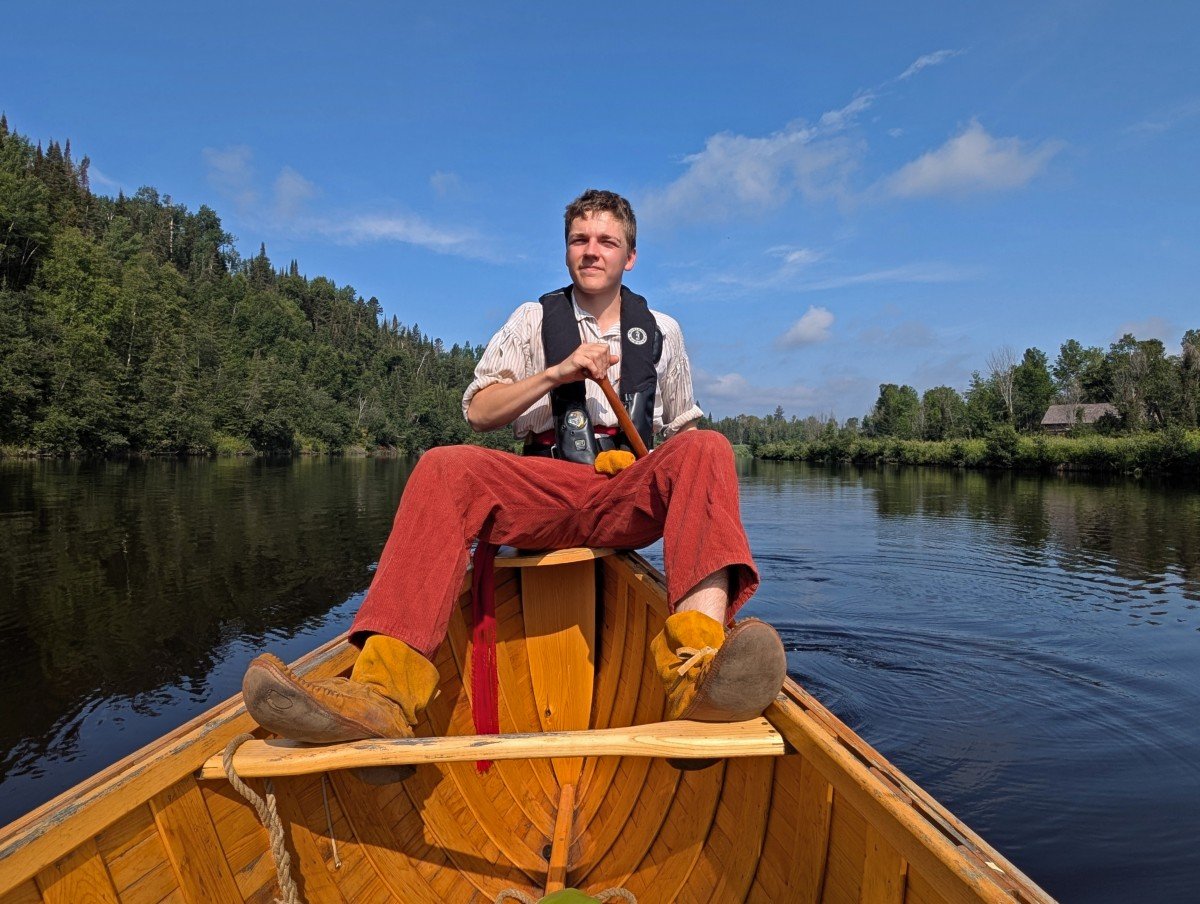
The 1850 Robinson Superior Treaty reduced Ojibwe land to a small reserve outside Fort William.
Another city, called Port Arthur, developed slightly further north along Lake Superior. Both settlements grew rapidly with western expansion, railway construction, grain shipping, and forestry. In 1970, Fort William and Port Arthur amalgamated as Thunder Bay, a name chosen by public vote over ‘Lakehead.’
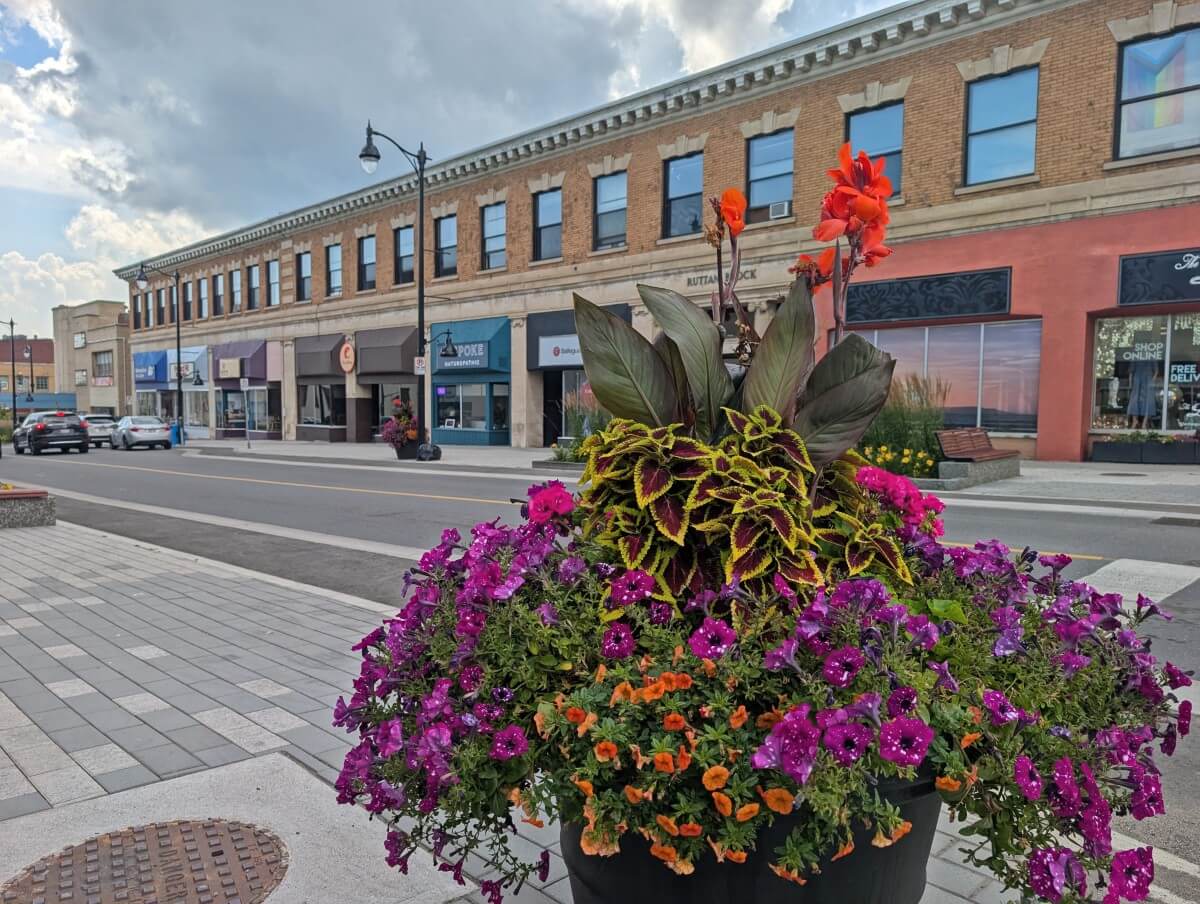
The distinct identities of Port Arthur and Fort William are still apparent now, though Thunder Bay pride is also alive and well. Another unique area is West Fort, which was the eastern terminus for the Canadian Pacific Railway.
Today, Thunder Bay is a growing city in Northwestern Ontario. It now has around 133,000 residents and is well connected to major cities like Toronto, Calgary and Ottawa. We flew there from Penticton via Calgary, with a total travel time of just five and a half hours (around two hours from Toronto).
Driving distances to Thunder Bay
Winnipeg, Manitoba – 702km, around 7 hours 30 minutes
Sault Ste. Marie, Ontario – 704km, around 7 hours 40 minutes
Duluth, Minnesota – 304km (189 miles), around 3 hours 30 minutes
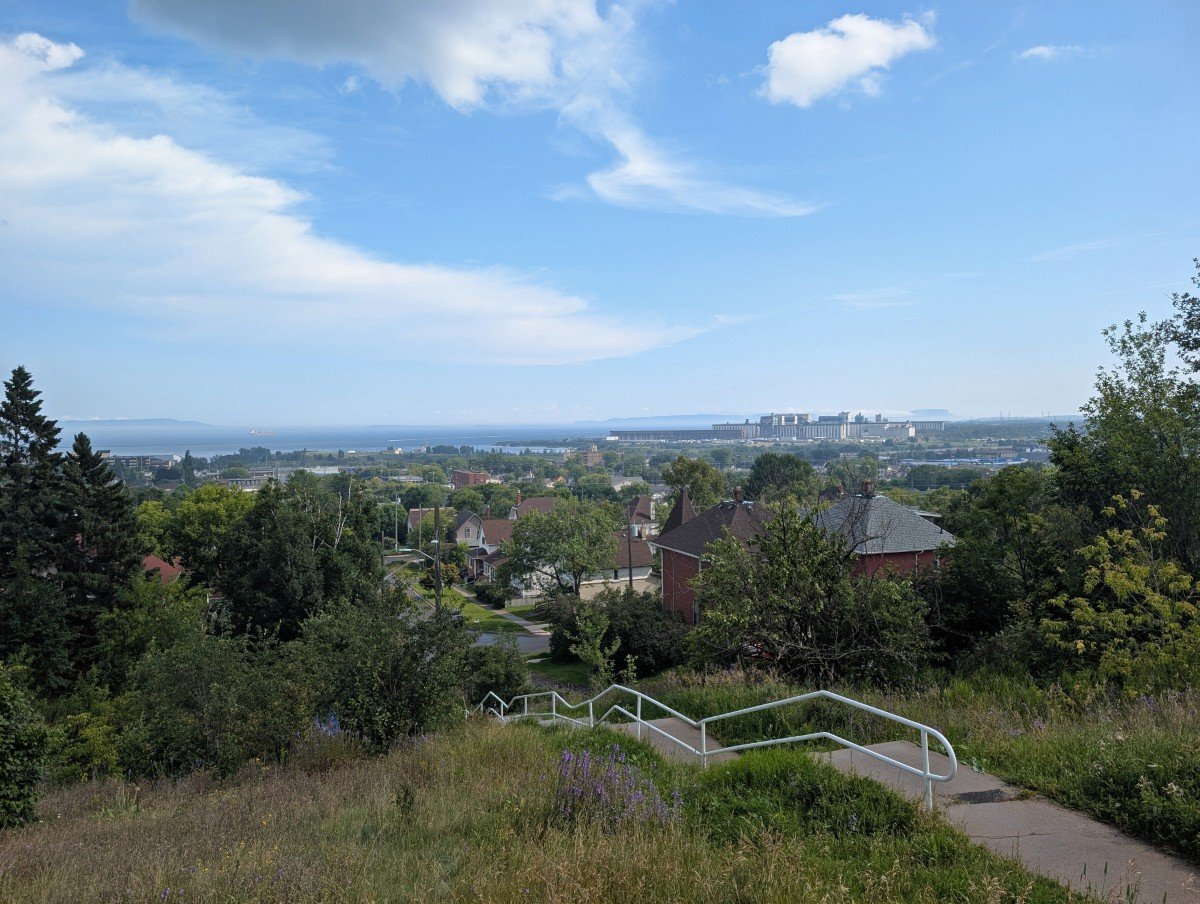
The best things to do outdoors in Thunder Bay
Looking for outdoor adventure in the Thunder Bay area? We’ve got you covered.
Read on to discover our tried and tested destinations, from waterfalls and hiking trails to epic canoe trips and one-of-a-kind suspension bridges. The map below has all of the mentioned activities and places to go.
A quick note – there was a lot of smoke drifting in to Thunder Bay from wildfires in the Prairies during our visit. Our photos are therefore a bit hazy, giving the landscapes a slightly muted look.
Tour spectacular waterfalls
Who knew Thunder Bay was home to so many incredible waterfalls?
While we’d visited the magnificent Kakabeka Falls while passing through on previous trips, we had no idea there were so many more in the area. Exploring all these waterfalls was hands-down the highlight of our recent trip.
Kakabeka Falls Provincial Park
Kakabeka Falls is Ontario’s second highest waterfall, plunging 40m into the Kaministiquia River. It is visible from a number of different viewing platforms. The resulting gorge is studded with 1.6 million year old fossils.
Beyond the main viewpoints, there is a choice of hiking trails to enjoy. The Little Falls Trail, for example, follows part of the historic portage around Kakabeka Falls and leads to an additional waterfall. There are three campgrounds if you’d like to stay longer in the area.
Kakabeka Falls is about 30 minutes drive west of Thunder Bay. There are provincial park day use fees.

High Falls, Pigeon River Provincial Park
High Falls was my biggest surprise on our late July trip to Thunder Bay! I was blown away with the size and force of this beautiful waterfall. And we had it all to ourselves….at least on the Canadian side.
This 28m tall waterfall is accessible via a 3km loop trail. Following the route of an old logging road, the upper route is wide and well established with a slight uphill. The lower trail offers views of the rugged canyon and has the remains of an 1930s lodge chimney.
The Pigeon River acts as a border line between Ontario and Minnesota, USA. The main parking area for the High Falls loop is only 500 m from the border buildings – be careful not to miss the turn! There is a $2 fee to park (cash only).
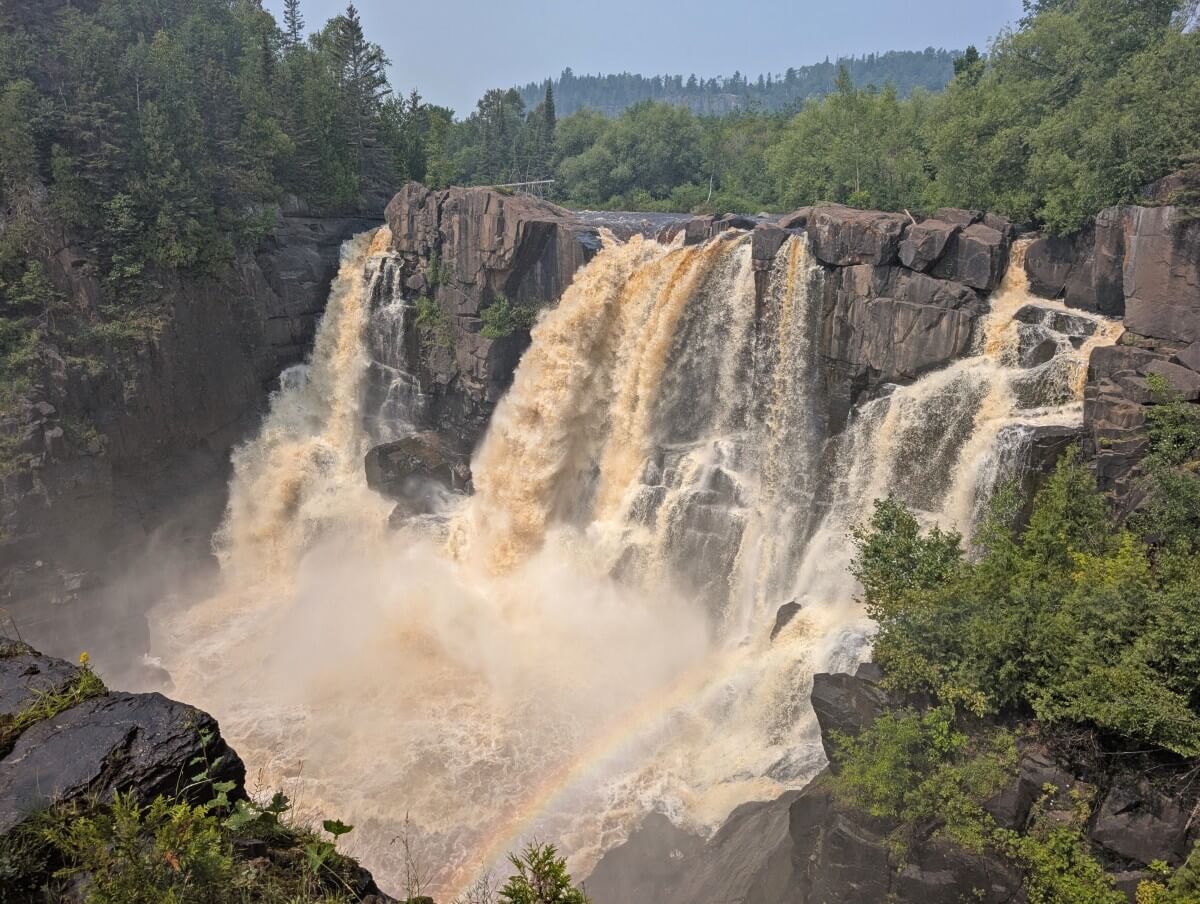
Middle Falls, Pigeon River Provincial Park
Middle Falls is a wide waterfall, stretching all the way across a flatter part of the river. The short walk to get there is mostly flat and is about 700m return. It was a little muddy in places during our visit.
The parking area for Middle Falls is on Highway 593. It can be easy to miss! Both Middle Falls and High Falls are about 1 hour drive from Thunder Bay. In my opinion, it is absolutely worth the trip.

Trowbridge Falls
Waterfalls just 15 minutes from downtown Thunder Bay? Yes, please!
Trowbridge Falls is a popular camping and mountain biking destination, just north of the city. Here, the Current River turns into a series of cascades and rapids. Some of them can be seen just five minutes walk from the main parking area, along a paved path.
If you want to stay longer, there is a large network of trails to explore, including some short loop routes. Trowbridge Falls is completely free to visit.
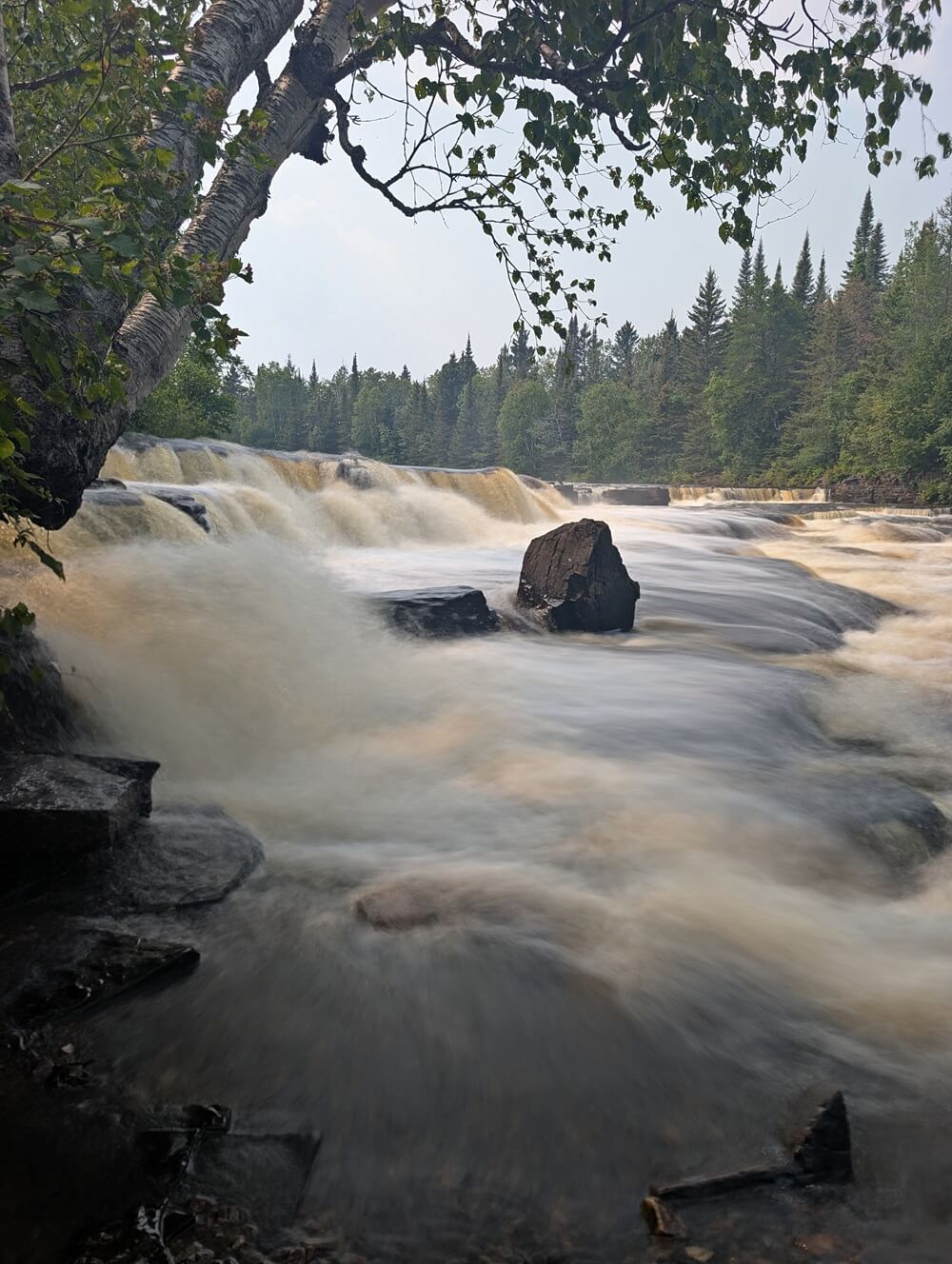
Cascades Conservation Area
Just a little further upstream from Trowbridge Falls is the Cascades Conservation Area. This well maintained forest area is around 400 acres and has some wonderful poplar and birch tree groves.
The Yellow Trail (1.8km return) provides the quickest access to the Current River. Multiple sets of rapids and cascades flow through exposed bedrock, some of which is almost pink or rusty red in colour. On hot days, locals swim in the pools.
Cascades Conservation Area is privately owned by the Lakehead Region Conservation Authority and there is a $5 vehicle fee to park.
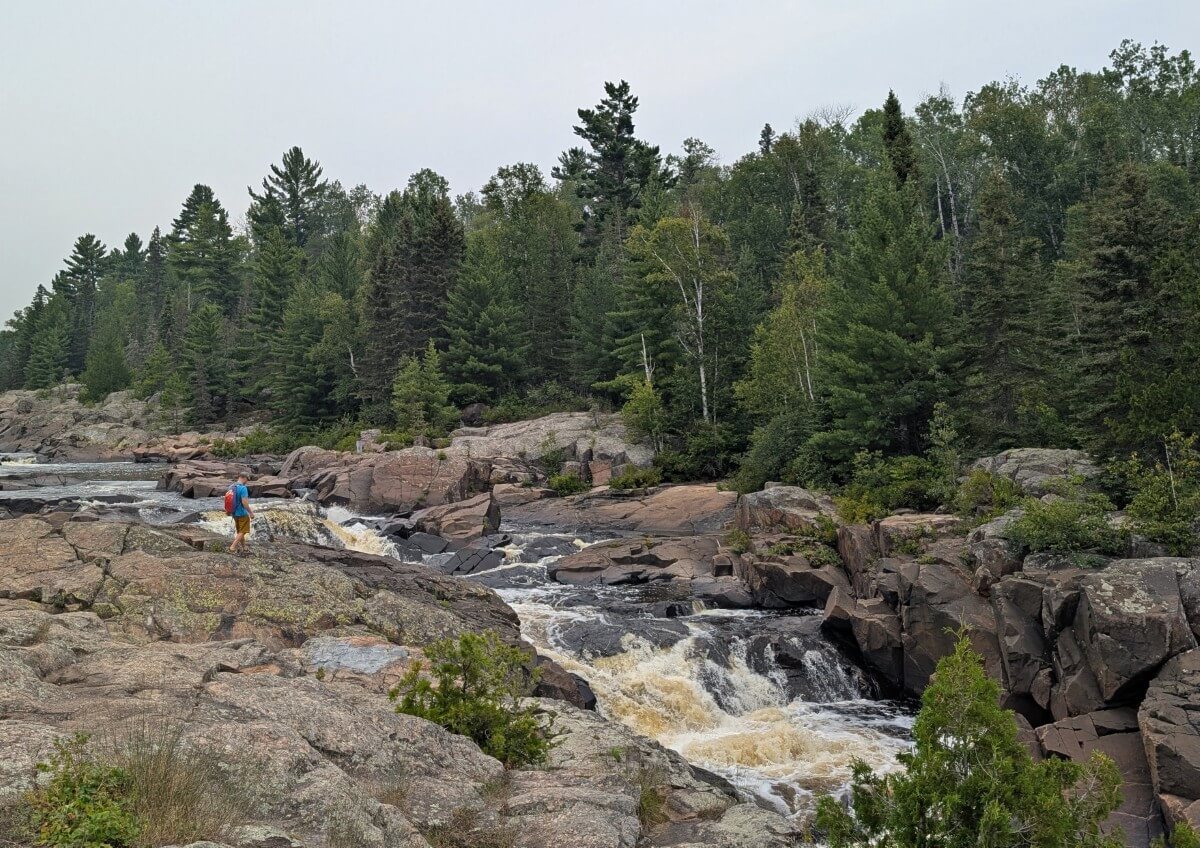
Hike the Top of the Giant Trail
The Top of the Giant Trail is an iconic Ontario hiking experience. The challenging 11km long trail (22km return) in Sleeping Giant Provincial Park culminates at the summit of Ontario’s highest cliffs, offering simply magnificent views of Lake Superior and the vertical gorge below.
We hiked the trail on a previous trip to Thunder Bay a few years ago. It took us 6 hours with a 30 minute lunch break at the top. Allow 8 to 10 hours if you’re a slower hiker. The first (and last) 7km is relatively flat. If you have bikes, consider bringing them to cycle this part.
For a scenic hike closer to Thunder Bay, we were recommended Lost Mountain. This 6.3km loop offers panoramic city and cliff views, with about 300m elevation gain. Allow 2 to 3 hours.
Head to our dedicated Top of the Giant Trail guide for all the details to tackle this famous hike!

Walk Canada’s longest suspension bridge
Did you know that Thunder Bay is home to Canada’s longest suspension bridge? It stretches 180m across the tall cliffs of Eagle Canyon, about an hour’s drive from the city. Walking it is a thrill like no other in this area!
There are actually two suspension bridges here, both included in the $23 ticket. There is an optional loop hike along the edge of the lake below the bridges, to add to the scenic experience.
I’ll admit it – I’m a bit scared of suspension bridges, especially when there are other people on them. Luckily, it was easy enough to wait until there was no-one else around at this one. And I did love the different perspective of the super steep cliffs!
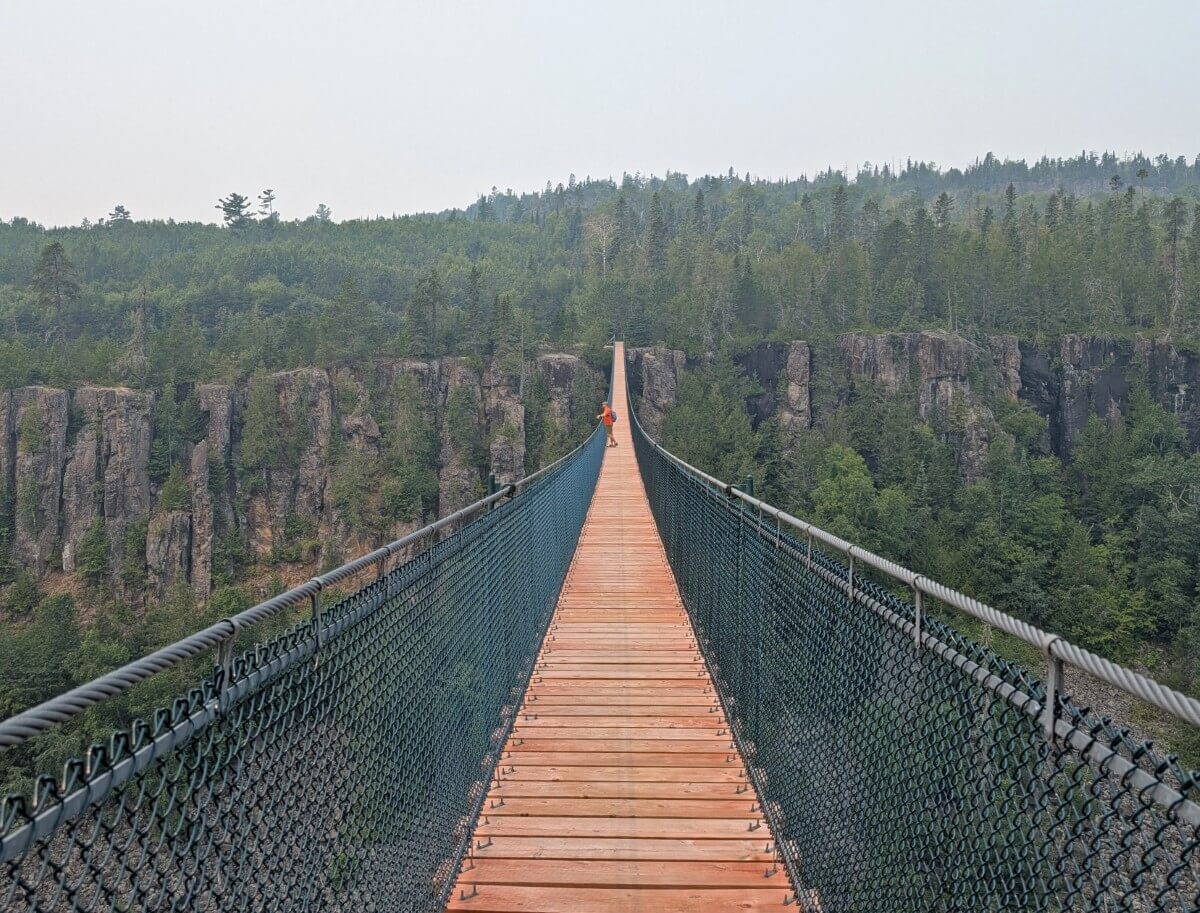
Take in the views at Ouimet Canyon Provincial Park
Ouimet Canyon is a must do while in the Thunder Bay area. It is very close to Eagle Canyon, about an hour from Thunder Bay by road.
An easy 1.2km loop trail leads to two viewpoint platforms at the edge of Ouimet Canyon’s high dramatically steep cliffs and weathered rock formations. 100m below, the cool, mist canyon floor is home to a variety of unusual Arctic plants. There is a $5 parking fee (cash only).

For viewpoints closer to town, check out Anemki Wajiw (Mount McKay), Hillcrest Park or the Bluffs. The 300m high Anemki Wajiw, ‘Thunder Mountain,’ is located on the Fort William First Nation and is considered sacred ground.
There is a fee to access the lower observation area ($10 on our visit). A hiking trail leads from the first parking area to the top of the hill itself, but I would seek permission at the toll gate first.

Paddle a voyageur canoe at Fort William Historical Park
Fort William Historical Park is a living museum, bringing a recreation of the 19th-century North West Company’s inland headquarters to life with interactive exhibits and reenactments. It’s definitely one of the best things to do in Thunder Bay.
A highlight for us was the opportunity to paddle a modern version of the voyageur’s birchbark canoes down the Kaministiquia River, complete with some French singing and stories from the past. Back then, it took around six weeks to paddle from Montreal to Fort William. The 700lb canoes would be loaded with 8000lb of supplies.
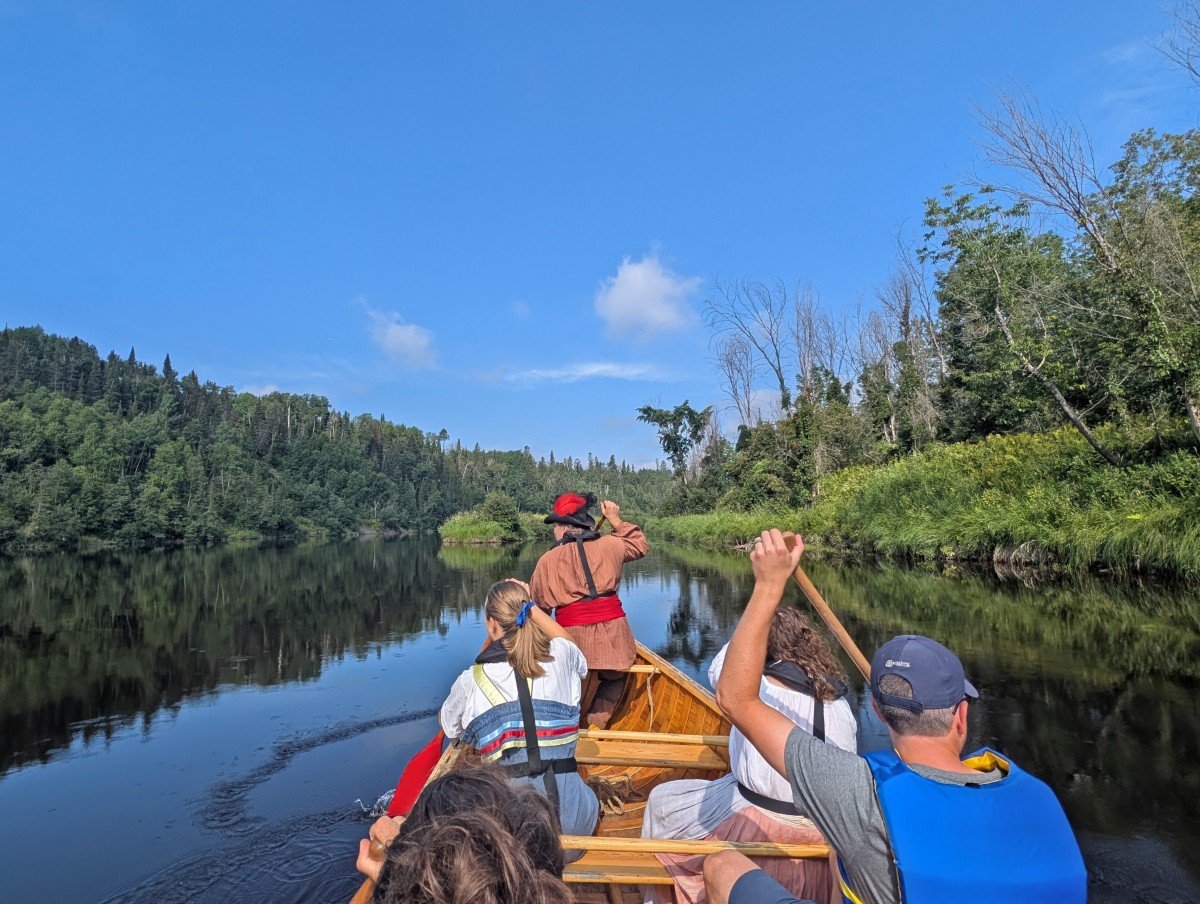
Canoe paddling aside, Fort William is well worth a large part of a day for both families and adults. There is just so much to see here, from the bakery (fresh bread every day!) and working farm to the canoe builder and apothecary. The staff are all in character, recreating events from 1815.
Before entering the walled Fort, visitors first encounter the Anishinaabe Encampment. This area represents the local Ojibway people, who were nomadic but usually spent summers in this region. Some stayed year round, sharing their knowledge and skills with the Europeans and trading goods like furs.

Dig for amethysts
The area between Thunder Bay and Nipigon is a hot spot for amethyst, a semi-precious quartz crystal. There are a bunch of amethyst mines here, of which a couple are open to the public.
Why visit an amethyst mine, you may ask? A literal pick-your-own adventure! We chose to visit family owned Diamond Willow Amethyst Mine as we liked that they only charged for the rocks and gems you keep. It is family owned as well.
The idea is simple – take a bucket and shovel, head to one of the open pits and get digging! Once you’ve found some treasures, you can clean them up at one of the stations and then choose which to bring home.
Always happy to be in the dirt, JR absolutely loved this experience! He found a couple of more rare dark amethysts as well as some purple ones. We paid only $10 for three big handfuls of rocks.
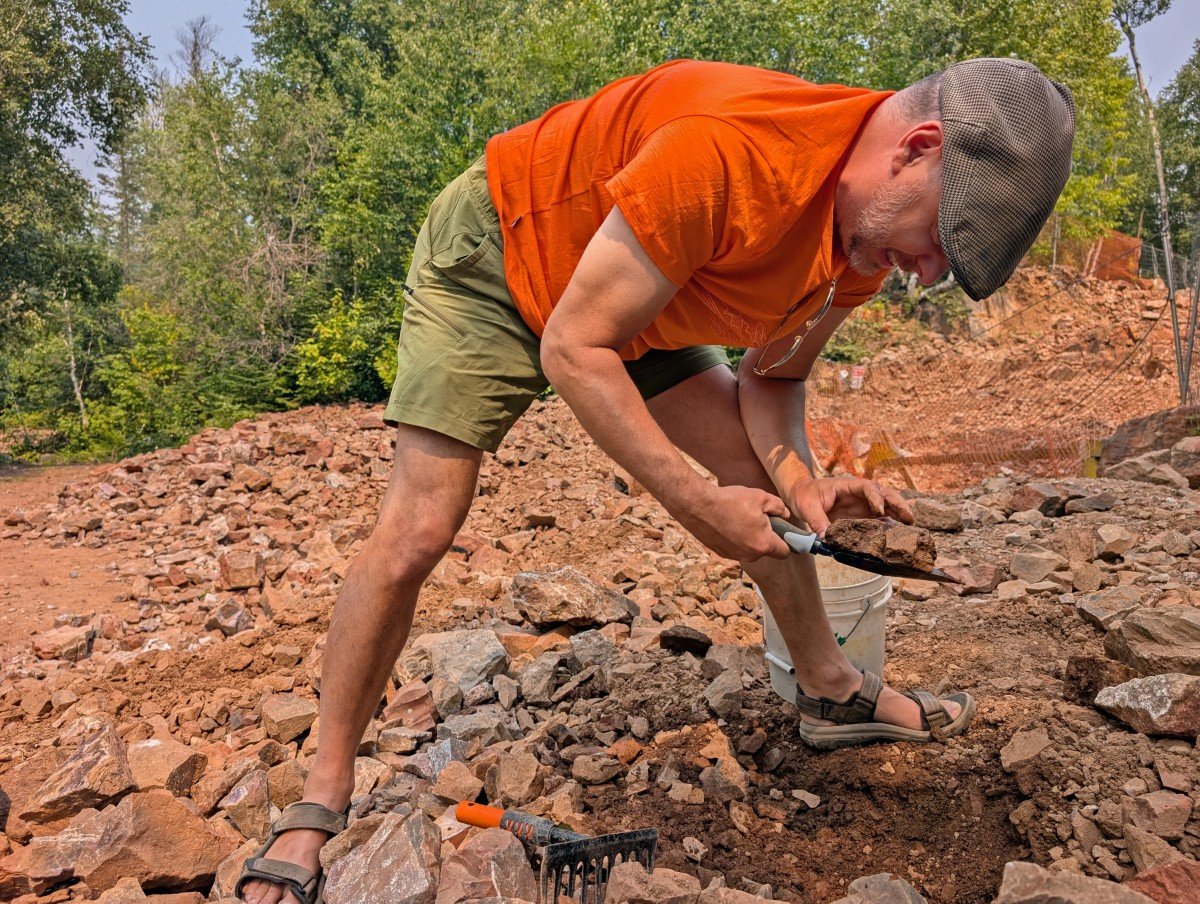
Go rock climbing
There are a ton of places to rock climb in and around Thunder Bay. And even better, there’s no line-ups. One of the closest places is the Bluffs, only 15 minutes drive from downtown. There’s a choice of short sport routes here, many with top rope access.
Another spot with easy access is Silver Harbour, just west of the city. Again, more sport climbing, with the routes ranging from ranging from 5.5 to 5.13a. And you’re super close to the lake!
Over 650 different climbs are featured in the Thunder Bay Climbing book, authored by Aric Fishman. Need a course or want a helping hand to find the best climbs? Aric is also the owner and guide of Outdoor Thrills and Skills. He’s available for ice climbing in the winter too.
If you’d prefer to stay inside, Thunder Bay will soon have its own bouldering gym – the Rock Room. Created by two local climbers, the 4,000 sq. ft facility is estimated to open in October 2025.
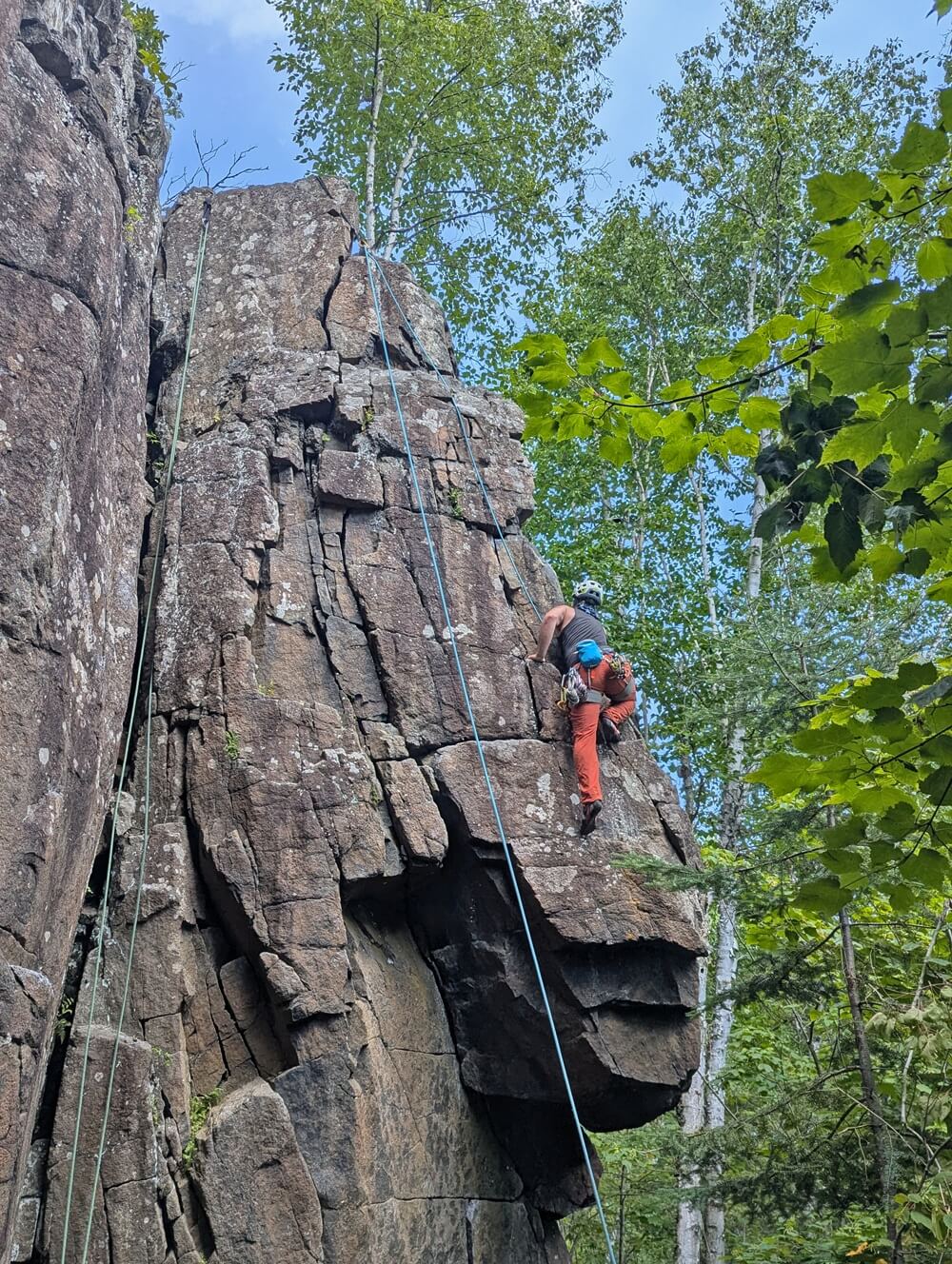
Cruise on Lake Superior
Vast and untamed, Lake Superior is Thunder Bay’s ever present and sometimes restless neighbour. Take to the water for a different perspective on both the city and lake. An easy way to do this is to join a tour with Sail Superior.
Choose your vessel – sailboat, zodiac or catamaran – and your style of adventure. Sail Superior offer relaxing cruises with wine and cheese, high-speed excursions across the bay or shuttles to local islands.
Our harbour sailboat tour showcased city, harbour and lighthouse views. We spotted pelicans and other seabirds and all of us had the chance to steer the boat. The team are great with kids so it’s the perfect family activity!

Embark on a multi-day canoe adventure in Quetico or Wabakimi
Thunder Bay is the jumping off point for two world class canoe paddling destinations – Quetico Provincial Park and Wabakimi Provincial Park. We are fortunate to have explored both within the last few years.
Quetico is two hours drive west of Thunder Bay and is around 1.1 million acres in size. Bordering Minnesota’s Boundary Waters Canoe Area, it comprises the largest international recreation area of its kind on the planet. Quetico is recognised as an International Dark Sky Park. More information in our complete Quetico guide!

Wabakimi is located to the north of Thunder Bay. The most popular entry point (around Armstrong) is three hours drive from the city. Wabakimi is over double the size of Quetico at 2.5 million acres. It primarily protects pristine boreal forest, which is home to the threatened woodland caribou.
Both parks provide incredible freedom for canoeists looking for a wilderness adventure. Of the two, Wabakimi is more raw. It can only be accessed by train, plane or canoe, which makes it far more remote and ensures you’ll encounter fewer people on the water. Head to our dedicated Wabakimi guide for all the details.
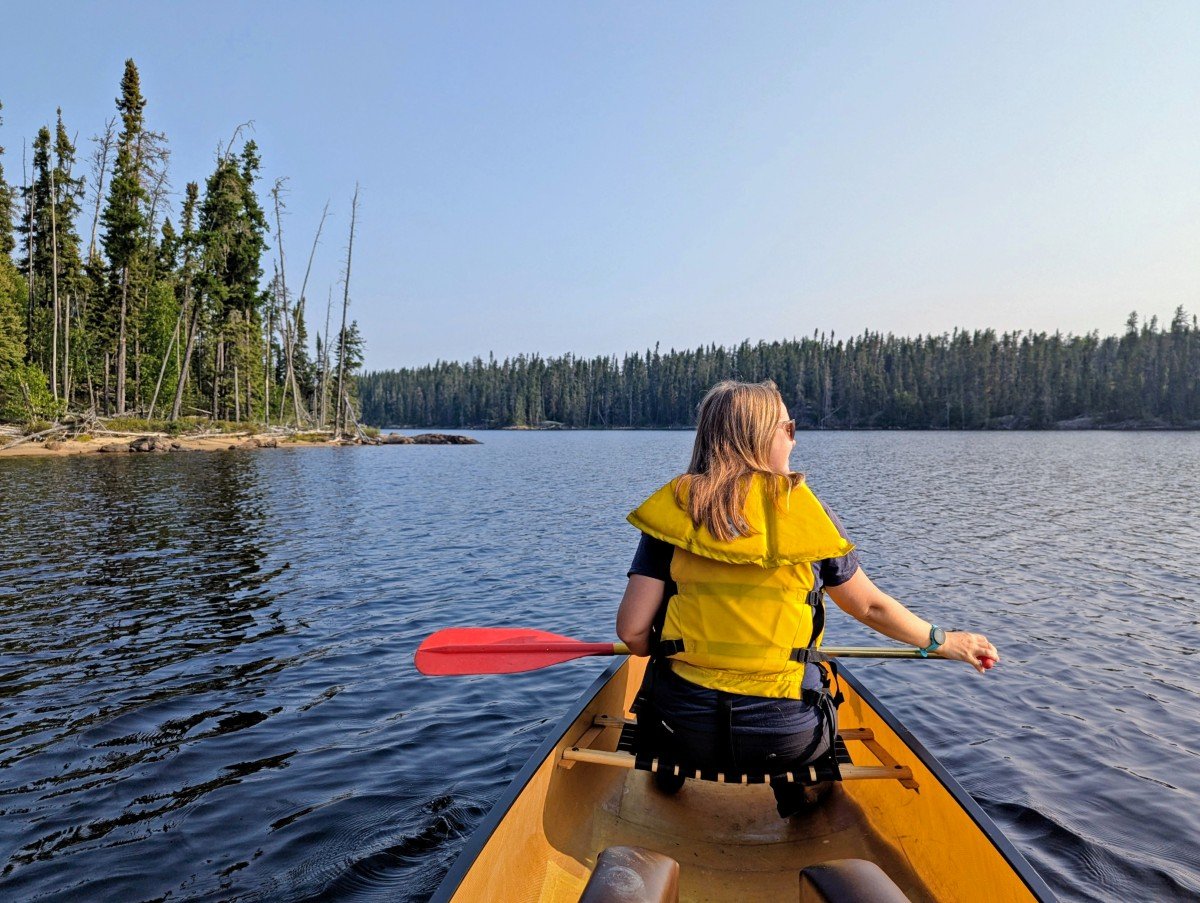
More great things to do in Thunder Bay
- Explore the waterfront area. Some of Thunder Bay’s industrial waterfront is being reclaimed to become beautiful public spaces
- Discover downtown street art. We found so many colourful murals along Cooke Street in downtown Thunder Bay
- Shop locally owned boutiques. Goods and Co. is the perfect destination, a downtown market featuring 25+ small shops and restaurants
- Enjoy free music in the park. A 100+ year old tradition, the Live on the Waterfront program offers the chance to see performers every Wednesday evening at Marina Park

- Tour the Thunder Bay Art Gallery, the largest public gallery between Sault Ste. Marie and Winnipeg. In 2027, it will be moving to a waterfront facility that will be twice the size
- Visit the Terry Fox National Historic Monument – it is located very close to where this inspirational runner was forced to end his incredible 5,342km long Marathon of Hope
- Learn more about local and regional heritage at the Thunder Bay Museum. There are historical walking tours of different city neighbourhoods available as well (additional fee)
- Discover more about the industrial side of the city at the Transportation Museum of Thunder Bay. The highlight is the Alexander Henry, a retired Coast Guard icebreaker ship
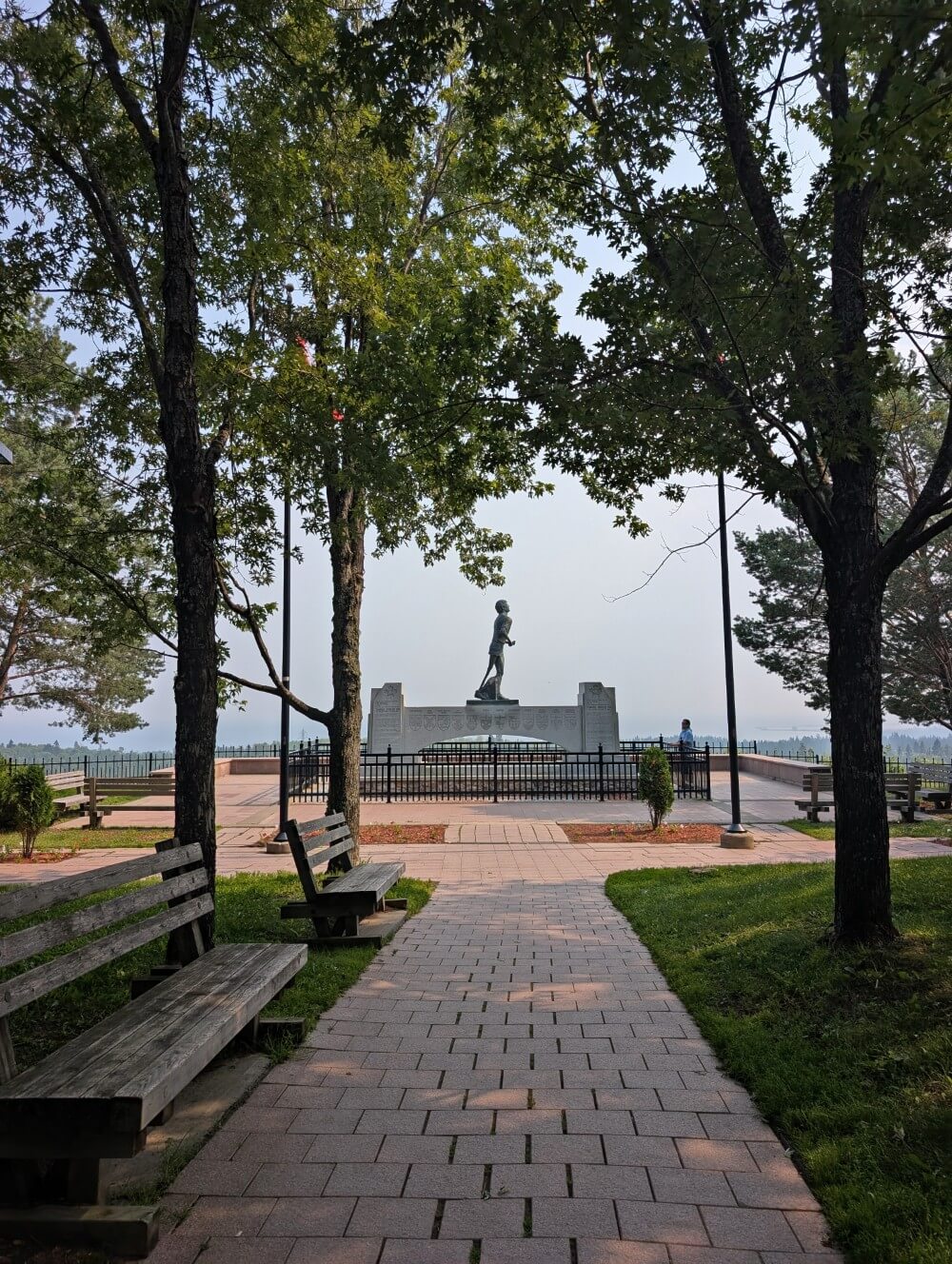
Where to eat in Thunder Bay
Thunder Bay’s food scene is thriving. We had some really memorable meals, with the highlight being dinner at Tomlin. This upscale, sophisticated spot feels like something straight out of a much larger city.
The food menu is super seasonal, local producer focused and designed for sharing. They don’t take reservations (only for groups 6 and over), so be sure to arrive early and be prepared to be put on the waitlist. The wait is more than justified.

While in the virtual line for Tomlin, consider heading to Lakehead Beer Company. It’s stylish taproom is just around the corner and has a wide choice in locally made brews. I loved their seasonal selection, including Cucumber Gose (super refreshing!) for summer.
Situated in a down-to-earth neighbourhood, the Nook serves up classic Italian favourites alongside a selection of innovative dishes. The patio is one of the best locally and the portions pretty generous.
A must eat in Thunder Bay is a Persian – a fried oval-shaped pastry topped with pink berry icing. A city staple since the 1940s, the Persian is said to have been named after American World War I General Joseph ‘Black Jack’ Pershing, who once visited a local bakery. Treat yourself at the Persian Man.

Other Thunder Bay eateries we would recommend include:
- Swell Bakery – Mouthwatering, freshly made pastries, super aesthetically pleasing and amazingly tasty. They are open until they sell out, which can be early
- Roosters Bistro – Welcoming downtown diner with well made breakfast and lunch staples. Very popular – go early!
- Giorg Cucina e Barra – Elegant destination for a romantic dinner or special celebration, with homemade pasta and extensive wine list
- Kangas Sauna – Diner favourites and authentic Finnish pancakes topped with berries and cream (about 10% of local residents claim Finnish descent)
- Prime Gelato – Immensely popular downtown gelato shop with locally inspired flavours
- Norteños Cantina – Super tasty street-inspired tacos, tortas, quesadillas in a funky venue, open late. The Wednesday birria special is a steal of a deal
- Maltese Grocery – Filling, fairly priced made-to-order sandwiches, perfect for busy days exploring

Where to stay in Thunder Bay
Serving as a key road trip stop between Winnipeg and Sault Ste. Marie, Thunder Bay boasts a wide selection of accommodations and good availability.
We first stayed at the Superior Shores Hotel, at the edge of the downtown area. The location is super convenient – we walked to most restaurants and waterfront attractions.
Recently renovated, the rooms are both wonderfully aesthetic and functional for modern travellers. Breakfast is included. On the downside, it isn’t the best for accessibility – the rooms are on the smaller side and there are steps to the elevator.
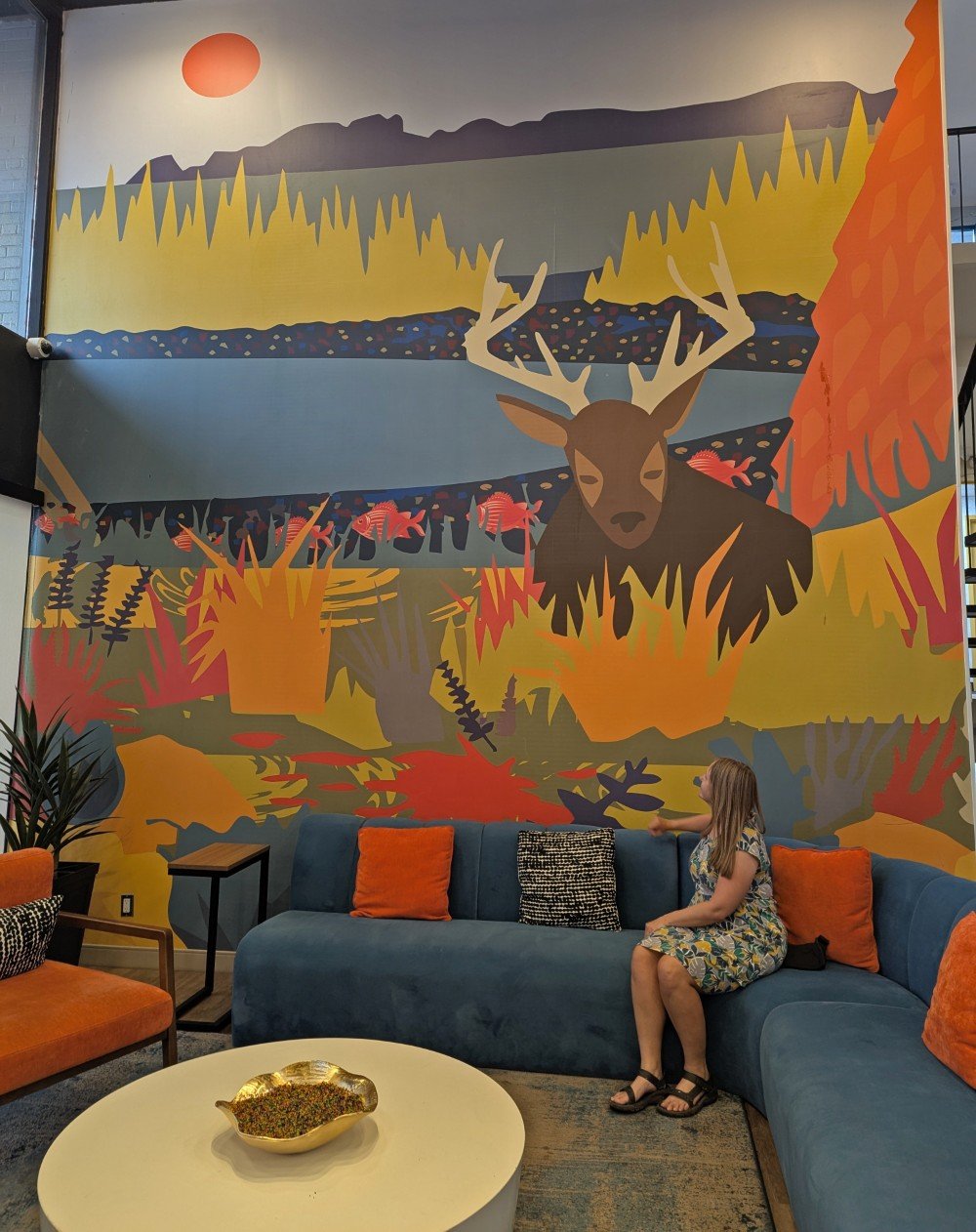
We wrapped up our Thunder Bay visit with a night at the Delta Hotel. It is situated right on the waterfront, with many rooms having lake views (including ours!) The building is very modern, with the rooms large and boasting lots of upscale features.
For a historical stay, check out the Prince Arthur Waterfront Hotel (a 1911 railway hotel built by the same architects as Grand Central Station in New York City) or the Courthouse Hotel (converted 100+ year old courthouse building). Both are well located for the downtown area.
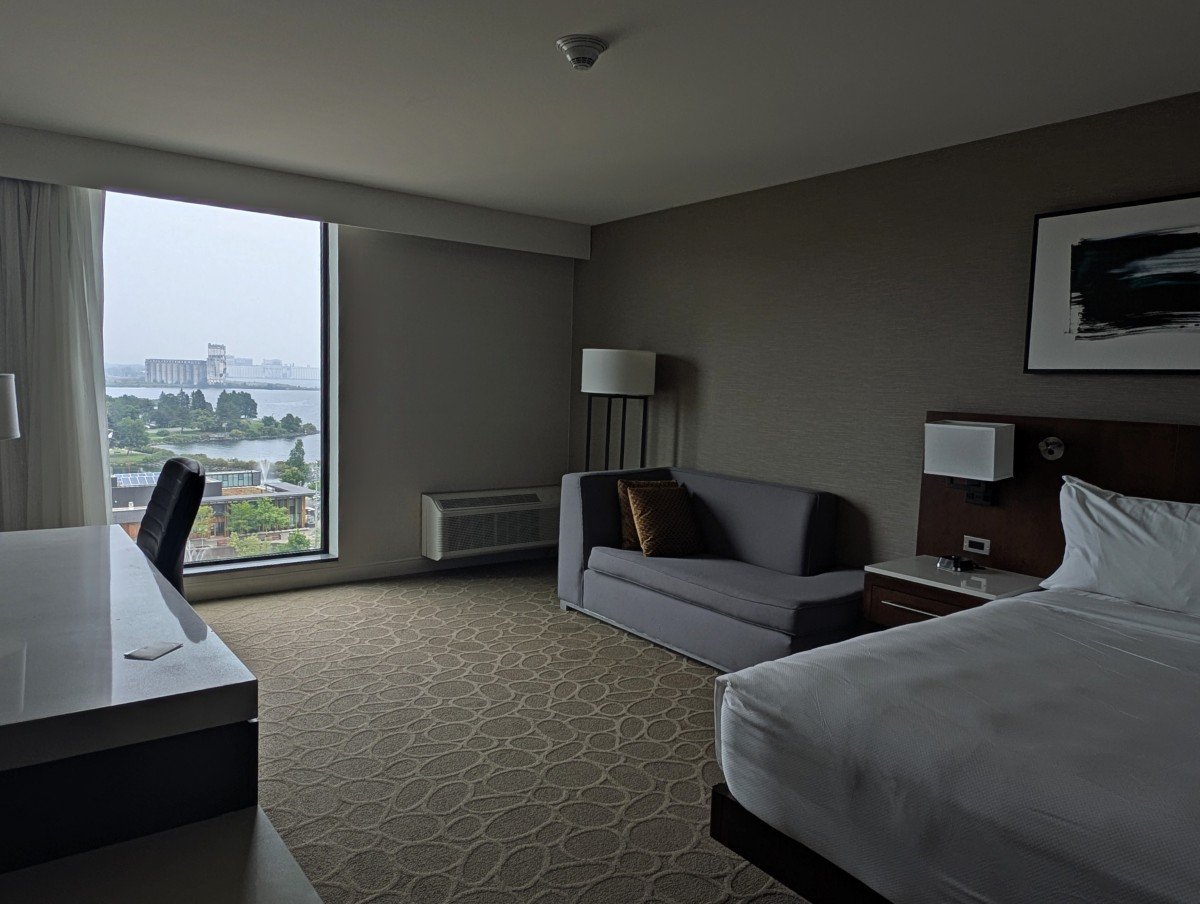
Other posts you may find helpful
Highway 17 Road Trip: 10 of the Best Ontario Parks
Lake Huron Fishing with Angling Algoma, Northern Ontario
Paddling the Trent Severn Waterway near Campbellford, Ontario
Algonquin Provincial Park, Ontario
Toronto to Vancouver Road Trip: 24+ Great Places to Stop
Check out these recently published posts:

One half of the Canadian/British couple behind Off Track Travel, Gemma is happiest when hiking on the trail or planning the next big travel adventure. JR and Gemma are currently based in the beautiful Okanagan Valley, British Columbia, Canada. Consider buying us a coffee if you have find any of our guides helpful!

